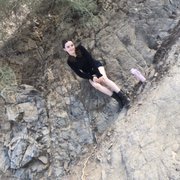Tom B.
Yelp
LAVA BEDS NATIONAL MONUMENT is located in between Mount Shasta and Crater Lake, if one follows the pathway of Interstate Highway 97. Lava Beds is about 50 miles to the northeast of Mt. Shasta and, about 70 miles further to the north, one arrives at Crater Lake National Park. The main features of Lava Beds are the "lava tubes" which, according to information from the park, are also called, "caves." Although Lava Beds will be fascinating to those interested in geology, tourists interested in gee-whiz scenery such as that found at Yosemite National Park or at Arches National Park, might l not warm up to the dry and desolate vistas at Lava Beds National Monument. But if your trip includes a visit to Mt. Shasta or Crater Lake, then I would recommend that Lava Beds be included in your travel agenda. Honeymooners who have spent their week of bliss on the Big Island of Hawaii (such as me), may be familiar with lava tubes, such as those called, Nahuku ("Thurston") lava tube, Kaumana Caves, Kazumura Caves, Kula Kai Caverns, and HueHue lava tube. My point here, is that a familiarity with the lava tubes on the Big Island will likely enhance your enthusiasm for the lava tubes at Lava Beds National Monument.
At the Visitor Center at Lava Beds, one finds a short road leading in the southerly direction, which then branches into a loop road, where the loop road passes the entrances to several nearby lava tubes. These lava tubes include, Thunderbolt, Golden Dome, South Labyrinth, Blue Grotto, Catacombs, Juniper, and Upper Sentinel. Travelers who plan to stop at Lava Beds need to remember to bring a flashlight or two, and to ensure that the batteries are new. We did not consider the need for flashlights, but the lights provided by other hikers were good enough for us to find our way through the darkness.
MY PHOTOGRAPHS. (1) Inside one of the lava tubes; (2) Sign by Visitor Center at Lava Beds National Monument; (3) Pile of obsidian chunks at a lava field to the south of Lava Beds National Monument, where this lava field is called, "Glass Mountain."
GLASS MOUNTAIN. I have attached here a map (described below) for finding Glass Mtn. (Please click on the map to expand it). Huge lava fields that contain piles of obsidian chunks can be found to the south of Lava Beds. One of these lava fields is located at "Glass Mountain." Please see the attached photograph of me posing by the edge of this field of obsidian chunks. I am wearing my "DOING GOOD" T-shirt, which was sold by San Francisco Mime Troupe at one of their plays at park in Berkeley, CA. The best map for finding Glass Mountain is on page 146 of California Geology (Sept./Oct. 1992) Medicine Lake Volcano and Lava Beds National Monument, Calif. Dept of Conservation, Division of Mines and Geology (32 pages total). Although this document is 32 pages long, the page number at the bottom of the page is, "146." Google maps is hopelessly confusing for finding the correct gravel road that leads from Route 97 to the edge of Glass Mountain. Coming from Mt. Shasta, drive east on Route 89, turn north at Route 49 and then there will be a V-shaped fork in the road, and you should take the right fork which is Route 49 (the left fork is Route 15). Continue north. If you reach Medicine Lake, you've gone a mile too far. And so, one mile before reaching Medicine Lake, you need to turn east on Route 97. After ten miles on Route 97, you'll see a small sign on the right shoulder that reads, "Glass Mountain." The gravel road will be across the street (across Route 97) from this sign. You should consult page 146 (as mentioned above) and print it out to keep as your roadmap. Then, if you want to see Lava Beds National Monument, go to Route 97, drive west, then turn north and pass Medicine Lake, then continue north until you pass Mammoth Crater, and the Monument entrance will be a short bit north of Mammoth Crater.
To conclude, visitors at Lava Beds who are interested in viewing the unusual piles of obsidian chunks should consider visiting one of the nearby obsidian lava fields. Please note that you are not allowed to take obsidian from these lava fields. I did buy a chunk of obsidian from a mineral store on the main street of the Town of Mount Shasta (I kept my receipt with me, in case I was stopped during my vacation trip). I still got the receipt: "Mount Shasta's Middle Earth The Crystal Room 109 West Castle St., Mount Shasta, CA." My receipt is dated, Aug. 21, 2009. I paid $23.60 for the small chunk of obsidian. Free internet info from USGS: (1) Lava Beds National Monument, California, USGS Bulletin 1673 (116 pages); (2) Geologic Field-Trip Guide to Medicine Lake Volcanoes, Northern California, Including Lava Beds National Monument. Report 2017-5022-K1 (68 pages); (3) California Geology (Sept./Oct. 1992) Medicine Lake Volcano and Lava Beds National Monument, Calif. Dept of Conservation, Division of Mines and Geology (32 pages total).













































